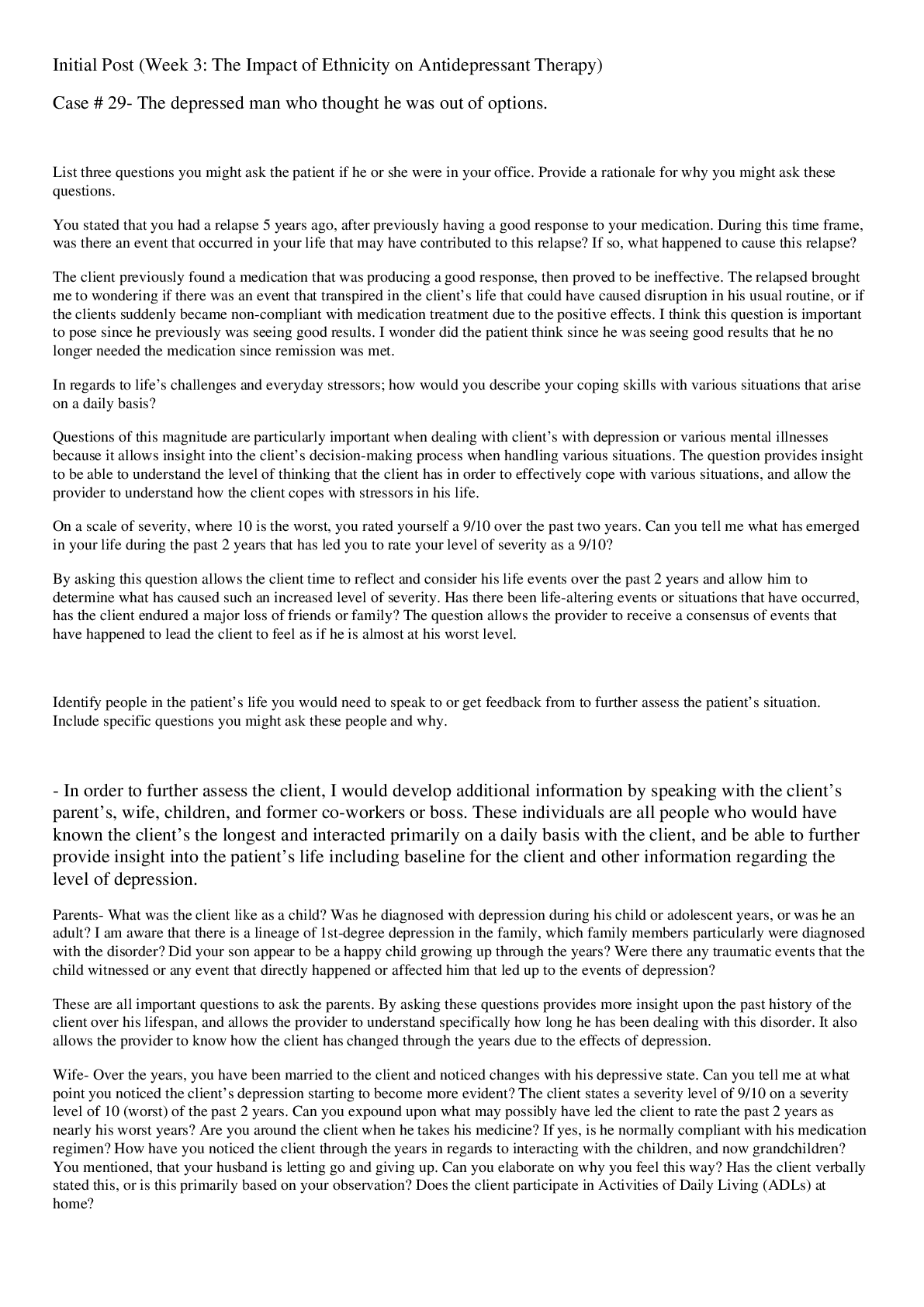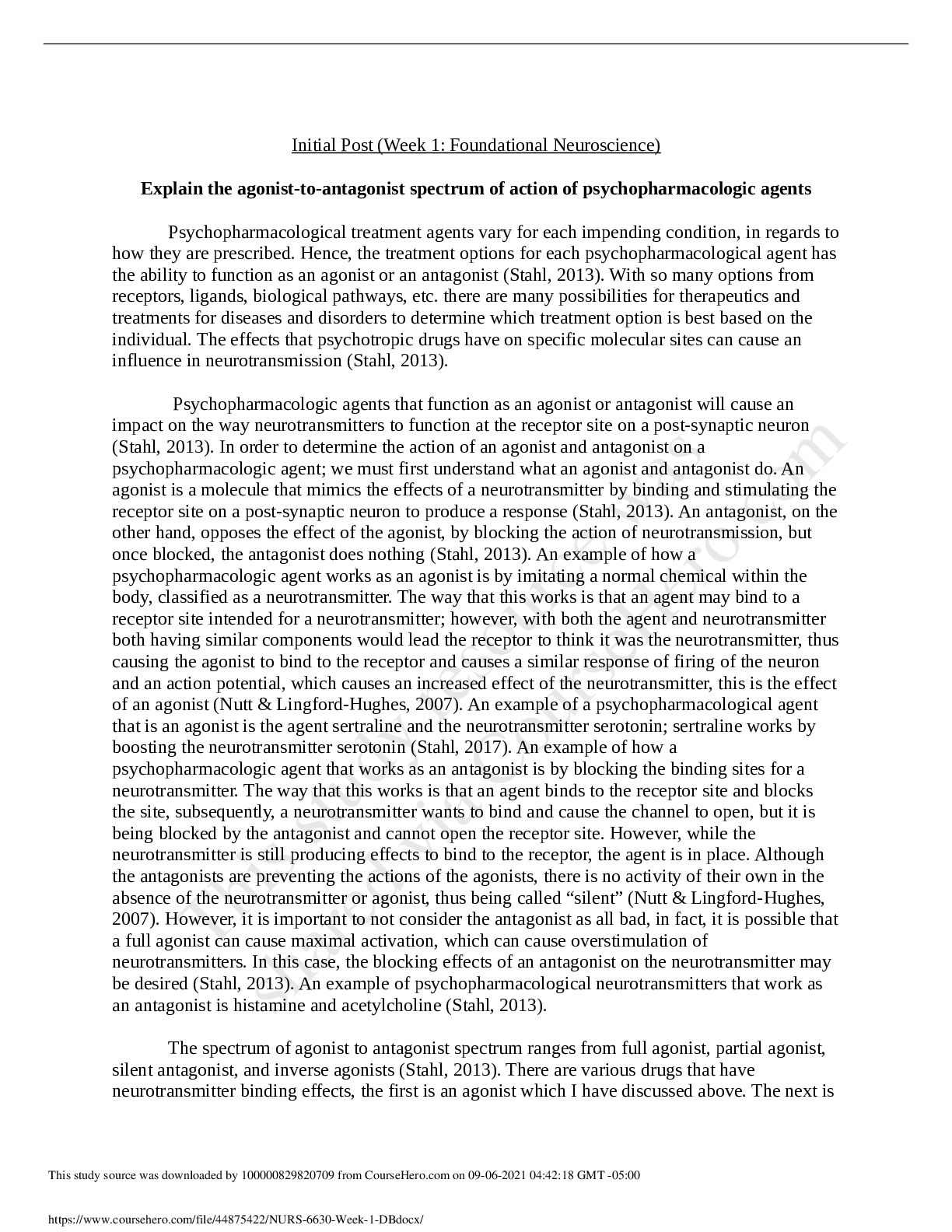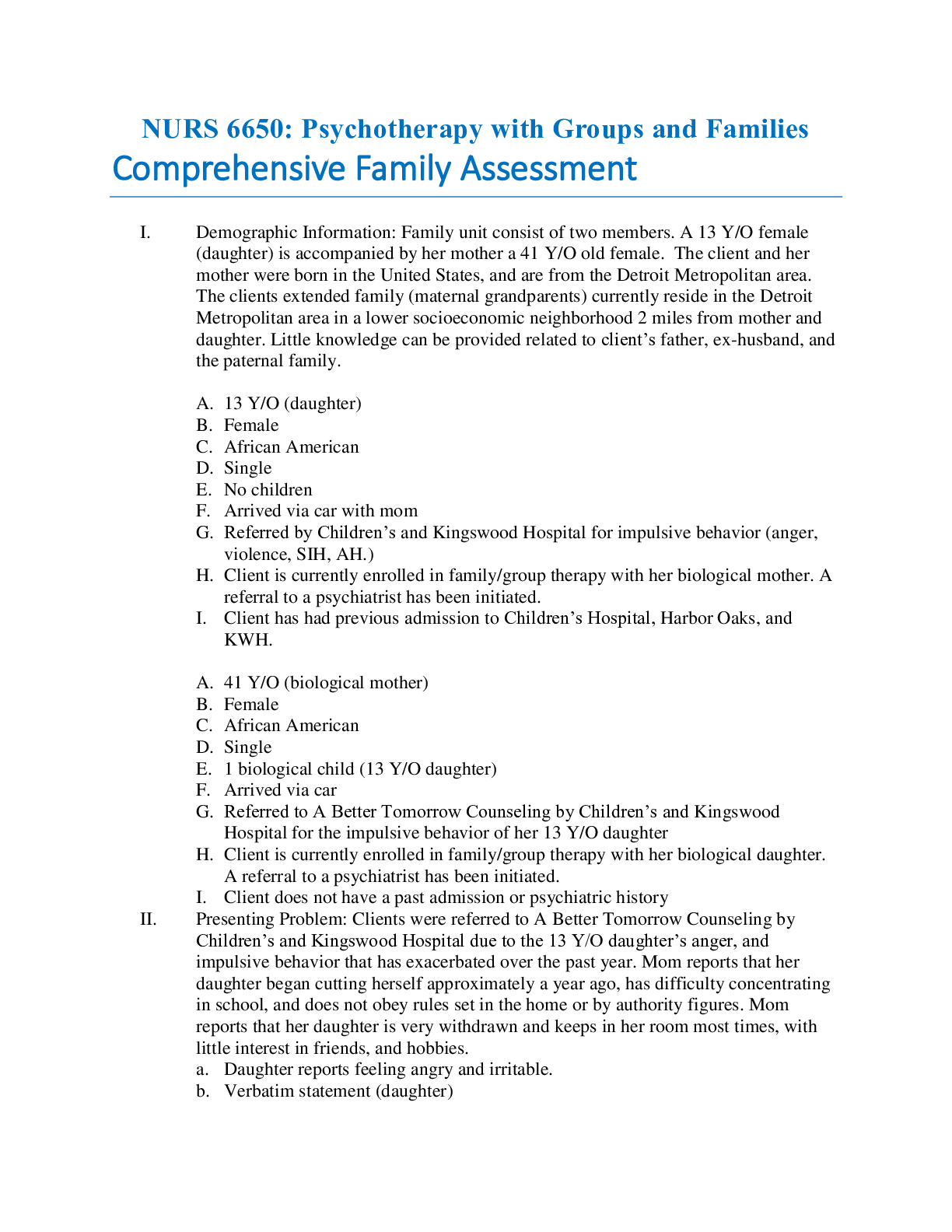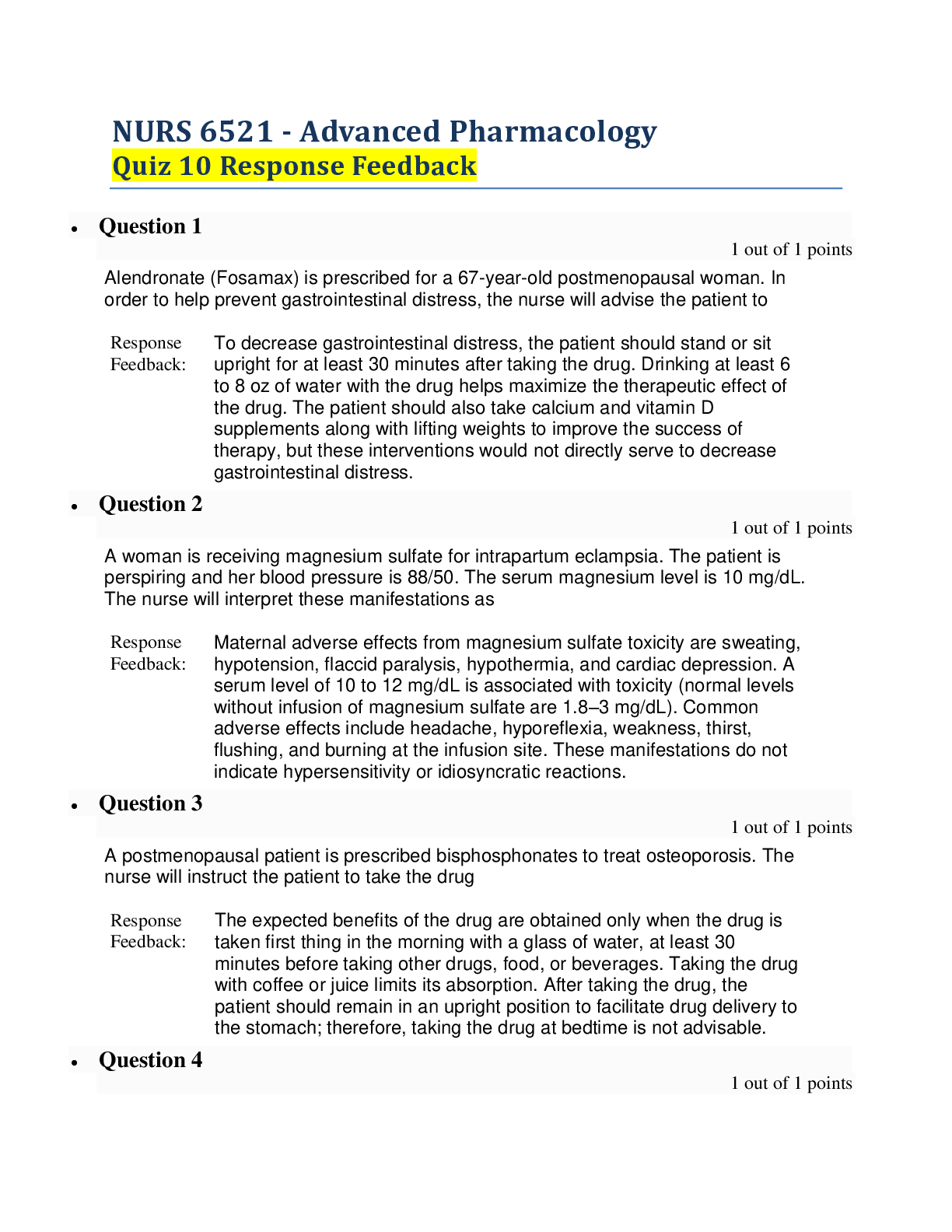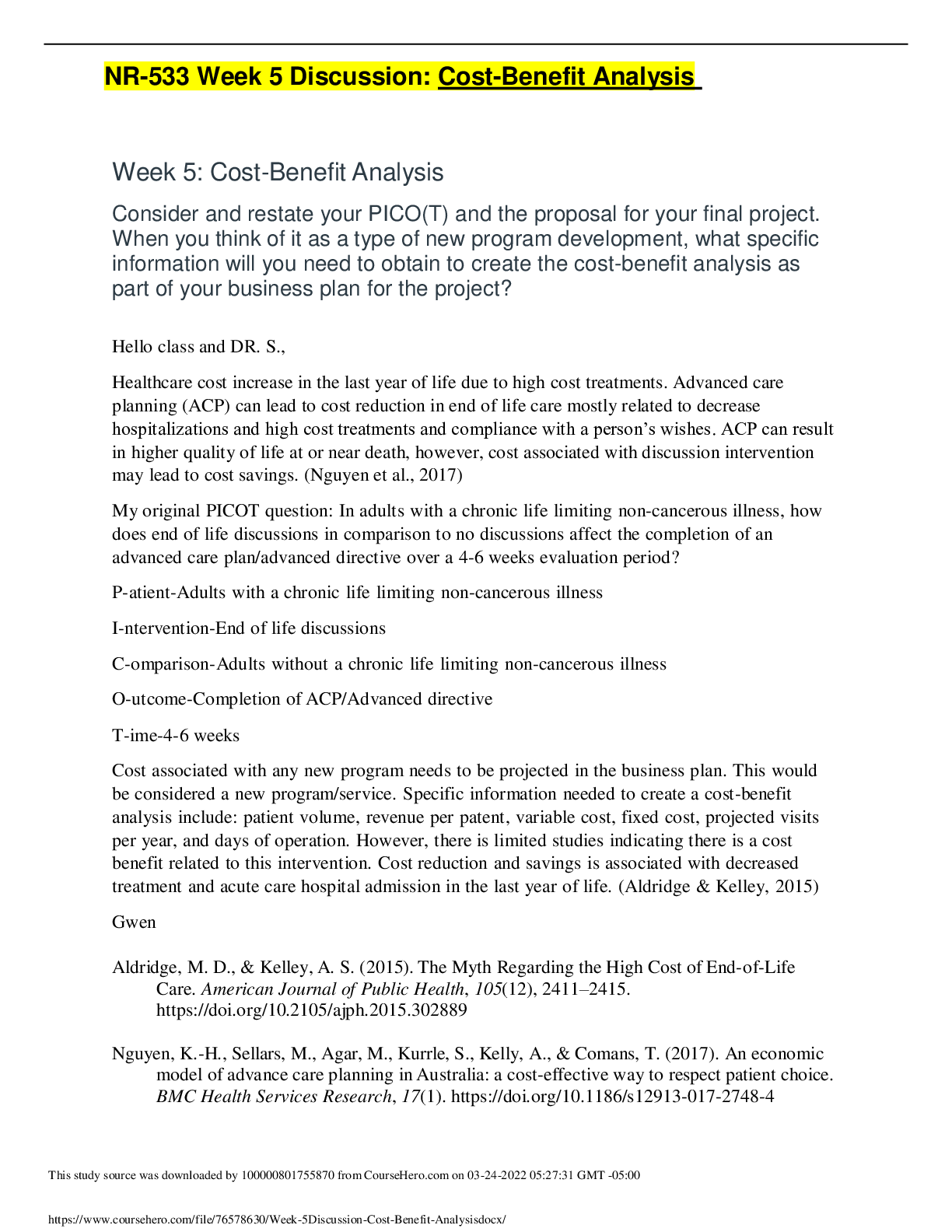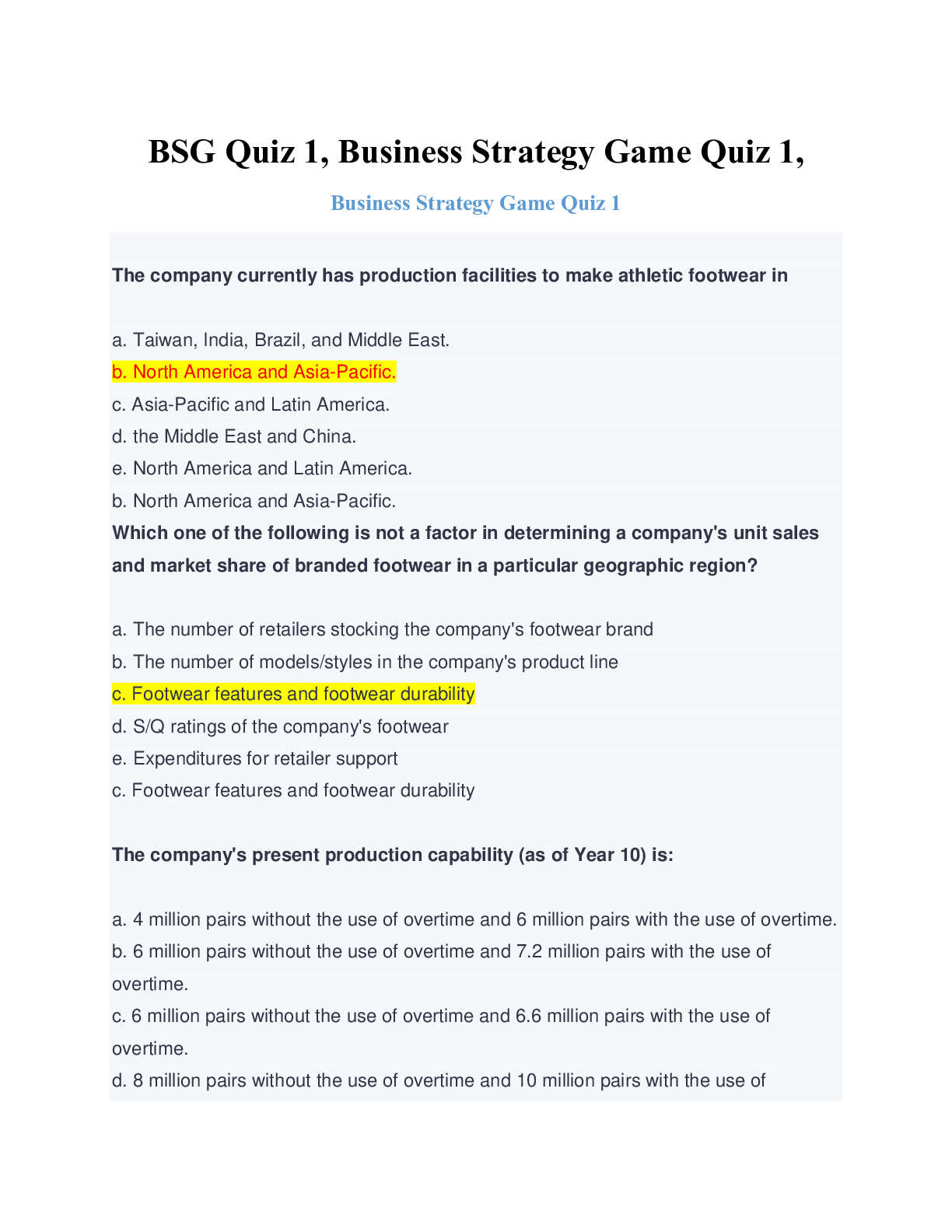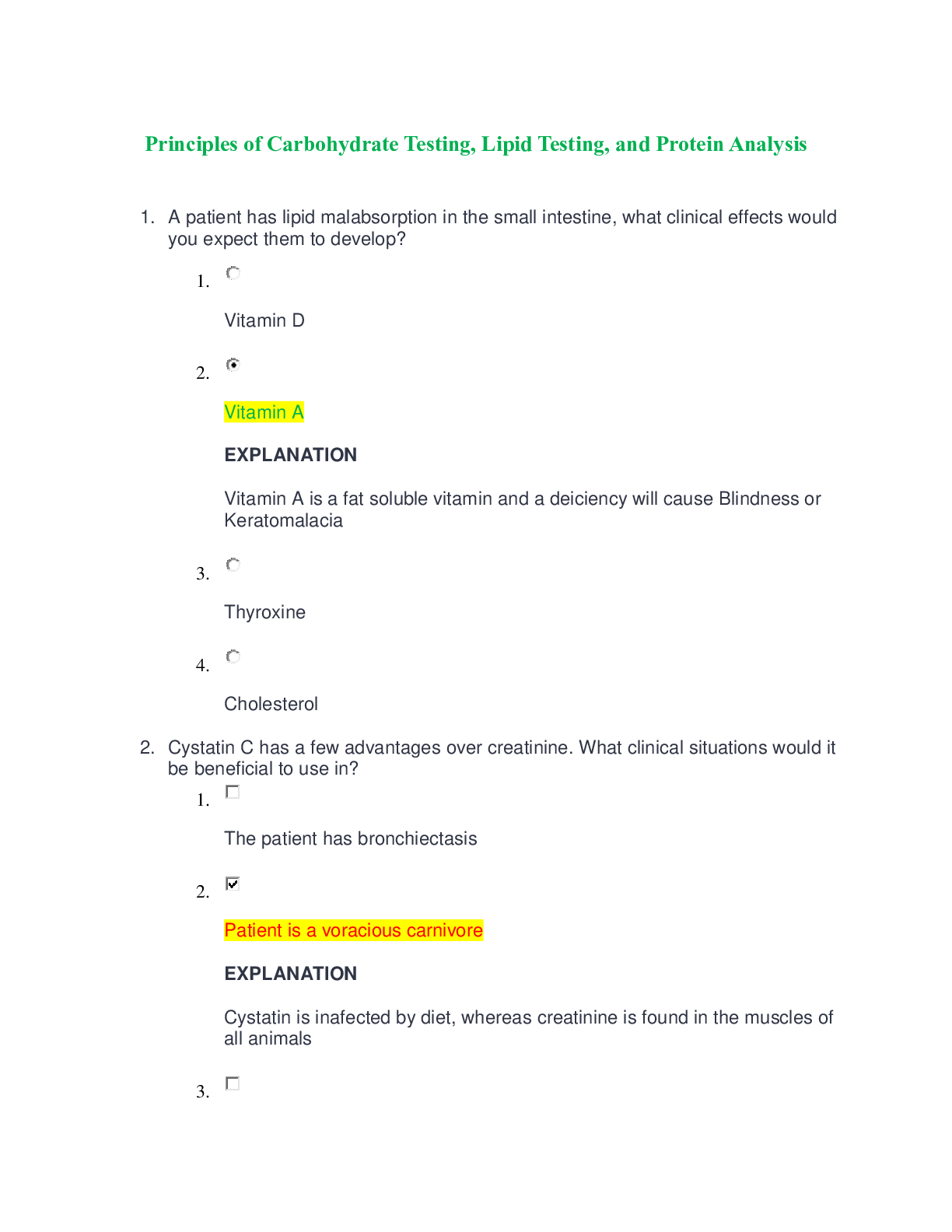Economics > QUESTIONS & ANSWERS > Middle Tennessee State University MBAE 6865 Economic Decisions for Managers. Module One Quizzes - KW (All)
Middle Tennessee State University MBAE 6865 Economic Decisions for Managers. Module One Quizzes - KW. All Answers Correct.
Document Content and Description Below
T Question 1 (1 point) Contribution margin is Question 1 options: the contribution of each unit sold towards covering the fixed costs the contribution of each unit sold towards covering the varia... ble costs the contribution of each unit sold towards covering the average variable costs All of the above Save Question 2 (1 point) In order to continue operating, in the long-run a firm must Question 2 options: Charge a price equal to its AVC Charge a price equal to its AFC Charge a price equal to its AC None of the above Save Question 3 (1 point) Hold-up problems usually occur when Question 3 options: One of the parties makes a heavy investment in equipment specific to its trading partner One of the firms decides to invest heavily in general purpose equipment Costs are avoidable Costs are incurred Save Question 4 (1 point) Which of the following will decrease the price needed to break even? Question 4 options: A decrease in overall fixed but avoidable costs A decrease in the marginal costs An increase in sunk costs Both A&BSave Question 5 (1 point) Firms that anticipate hold-up, choose organizational or contractual forms Question 5 options: that give both parties the incentive to make relationship-specific investments that give both parties the incentive to exploit each other’s positions that gives both parties an incentive to trade, even after the relationship-specific investments have been made Both A&C Save Question 6 (1 point) If the annual interest rate is 10%, the net present value of receiving $550 in the next year is: Question 6 options: $550 $551 $549 $500 Save Question 7 (1 point) The lower the interest rates Question 7 options: the more value individuals place on future dollars the less value individuals place on future dollars less investments will take place does not affect the investment strategy Save Question 8 (1 point) Which of the following variables are needed to determine the break-even quantity? Question 8 options: Marginal costs Fixed Costs Selling Price All of the above SaveQuestion 9 (1 point) Projects with a positive NPV create Question 9 options: economic profits since they earn a return higher than the company’s cost of capital economic profits since they earn a return lower than the company’s cost of capital accounting profits only since they earn a return higher than the company’s cost of capital accounting profits only since they earn a return lower than the company’s cost of capital Save Question 10 (1 point) If a firm sells more than the break-even quantity, Question 10 options: It will make a profit It will only cover the variable costs It will make a loss A firm is unable to sell above the break-even quantity Save Question 11 (1 point) If a firm anticipates that it is at a risk of being held up, it is more likely to Question 11 options: forgo the transaction completely merge with its trading partner exchange “hostages” All the above Save Question 12 (1 point) If the annual interest rate is 0%, the net present value of receiving $550 in the next year is Question 12 options: $550 $551 $549 $500 Save Question 13 (1 point)If the interest rate is 11%, $1500 received at the end of 12 years is worth how much today? Question 13 options: 1500*(1+0.11)^12 1500/(1 +0 .11)^12 1500/(1 + 11)^12 1500 Save Question 14 (1 point) Which of the following will decrease the break-even quantity? Question 14 options: Falling fixed costs Increasing marginal costs An increase in the price Both A&C Save Question 15 (1 point) Which of the following defines a sunk cost? Question 15 options: Cost of the next best alternative Cost of producing an additional unit An asset with no scrap value Total cost of producing a product Save Question 16 (1 point) A firm’s fixed costs are $10 million. It sets the price at $1800 per unit and has marginal costs of $1,000. The break-even quantity is Question 16 options: 10000 5,555 12,5005,000 Save Question 17 (1 point) A firm sells 300,000 units per week. It charges $ 35 per unit, the average variable costs are $40, and the average costs are $55. At what price does the firm consider shutting-down in the long run? Question 17 options: $45 $40 $95 $55 Save Question 18 (1 point) A firm is deciding between two different sewing machines. Technology A has fixed costs of $500 and marginal costs of $50 whereas Technology B has fixed costs of $250 and marginal costs of $100. If the price is $60 per unit, what is the break even amount of units for technology B? Question 18 options: 50 60 70 None-They would have to shut down Save Question 19 (1 point) A firm is deciding between two different sewing machines. Technology A has fixed costs of $500 and marginal costs of $50 whereas Technology B has fixed costs of $250 and marginal costs of $100. What is the cost of production at the number of units where the company is indifferent between the two technologies? Question 19 options: $750 $850 $950 $1050 Save Question 20 (1 point)A firm sells 1000 units per week. It charges $70 per unit, the average variable costs are $25, and the average costs are $65. In the long run, the firm should Question 20 options: Shut down since price is greater than average cost Continue operating price is higher than average cost, its making a profit Continue operating as the firm is covering all the variable costs and some of the fixed costs Shut-down because it is cost effective to pay off the remaining fixed costs Question 1 (1 point) Which of the following will increase the break-even quantity? Question 1 options: A decrease in overall fixed costs A decrease in the marginal costs A decrease in the price level An increase in price level Save Question 2 (1 point) The break-even quantity is Question 2 options: Fixed Costs/Price Fixed Costs/Marginal Cost Fixed Costs/(Price – Marginal Costs) Contribution Margin/Fixed Costs Save Question 3 (1 point) The higher the interest rates Question 3 options: the more value individuals place on future dollars the more value individuals place on current dollars individuals do not place any importance on either current or future dollars does not affect the investment strategy Save Question 4 (1 point)In the short-run, a firm’s decision to shut-down should not take into consideration Question 4 options: Avoidable costs Variable costs Fixed costs Marginal costs Save Question 5 (1 point) Break-even quantity is a point where Question 5 options: the level of profit is maximized the level of cost is minimized Only variable costs are covered There are zero profits Save Question 6 (1 point) Which of the following will increase the price needed to break even? Question 6 options: A decrease in overall fixed costs A decrease in the marginal costs An increase in fixed costs An increase in the level of production Save Question 7 (1 point) A firm will shut down in the short-run if Question 7 options: P>AVC P≤AVC Profits<0 P Save Question 8 (1 point)A firm will shut down in the long-run if Question 8 options: P>AVC P<AC P=ATC P>ATC Save Question 9 (1 point) What are some of the solutions for a hold-up problem? Question 9 options: Mergers Contracts Exchange of ‘hostages’ All the above Save Question 10 (1 point) According to the Net Present Value (NPV) rule, managers choose to invest if Question 10 options: The NPV of the project is less than zero The NPV of the project is greater than zero The NPV of the project is equal to zero The NPV of the project is equal to the cost of capital Save Question 11 (1 point) If a firm anticipates that it is at a risk of being held up, it is more likely to Question 11 options: forgo the transaction completely merge with its trading partner exchange “hostages” All the above Save Question 12 (1 point)Total will decrease the break-even quantity? Question 12 options: Falling fixed costs Increasing marginal costs An increase in the price Both A&C Save Question 13 (1 point) If the annual interest rate is 0%, the net present value of receiving $550 in the next year is Question 13 options: $550 $551 $549 $500 Save Question 14 (1 point) If a firm sells more than the break-even quantity, Question 14 options: It will make a profit It will only cover the variable costs It will make a loss A firm is unable to sell above the break-even quantity Save Question 15 (1 point) Which of the following defines a sunk cost? Question 15 options: Cost of the next best alternative Cost of producing an additional unit An asset with no scrap value Total cost of producing a product SaveQuestion 16 (1 point) A firm sells 1000 units per week. It charges $15 per unit, the average variable costs are $10, and the average costs are $25. In the short run, the firm should Question 16 options: Shut-down as the firm is making a loss of $10,000 per week Shut-down as price is lower than average cost Continue operating as the firm is covering all the variable costs and some of the fixed costs Shut-down because it is cost effective to pay off the remaining fixed costs Save Question 17 (1 point) A firm is deciding between two different sewing machines. Technology A has fixed costs of $500 and marginal costs of $50 whereas Technology B has fixed costs of $250 and marginal costs of $100. If the company plans to produce 9 units, which technology should the firm choose? Question 17 options: Technology A Technology B Either technology because they are equally cost efficient Need more information Save Question 18 (1 point) A firm sets its price at $10.00 per unit. It has an average variable cost of $8.00 and an average fixed cost of $4.00 per unit. In the short run, this firm is Question 18 options: incurring a loss of $2.00 per unit and should shut down. unable to cover all of its fixed cost and hence should shut down. incurring a profit. incurring a loss per unit of $2.00, but since it can still cover its variable costs, should continue to operate Save Question 19 (1 point) A firm sells 1000 units per week. It charges $70 per unit, the average variable costs are $25, and the average costs are $65. In the short run, the firm should Question 19 options:Shut-down as the firm is making a loss of $15,000 per week Shut-down as price is lower than average cost Continue operating as the firm is covering all the variable costs and some of the fixed costs Shut-down because it is cost effective to pay off the remaining fixed costs Save Question 20 (1 point) A firm sells 300,000 units per week. It charges $ 35 per unit, the average variable costs are $40, and the average costs are $55. In the long run, the firm should Question 20 options: Shut-down as the firm is making a loss of $15 million per week Shut-down as the firm cannot cover the variable costs Shut down because the price is lower than average cost None of the above 5 0 The higher the interest rates Question options: the more value individuals place on future dollars the more value individuals place on current dollars individuals do not place any importance on either current or future dollars does not affect the investment strategy Question 9 If the annual interest rate is 10%, the net present value of receiving $550 in the next year is: Question options: $550 $551 $549$500 Question 10 The lower the interest rates Question options: the more value individuals place on future dollars the less value individuals place on future dollars less investments will take place does not affect the investment strategy Question 12 Which of the following will increase the break-even quantity? Question options: A decrease in overall fixed costs A decrease in the marginal costs A decrease in the price level An increase in price level Ch 5 Medium 19 0 / 1 point A firm sells 300,000 units per week. It charges $ 35 per unit, the average variable costs are $40, and the average costs are $55. At what price does the firm consider shutting-down in the long run? Question options: $45 $40$95 $55 o 0 / Which of the following will increase the break-even quantity? Question options: A decrease in overall fixed costs A decrease in the marginal costs A decrease in the price level An increase in price level Question 8 0 / 1 point If a firm anticipates that it is at a risk of being held up, it is more likely to Question options: forgo the transaction completely merge with its trading partner exchange “hostages” All the above Question 10 0 / 1 point The lower the interest rates Question options: the more value individuals place on future dollars the less value individuals place on future dollars less investments will take place does not affect the investment strategy Ch 5 Medium Question 17 0 / 1 point A firm sets its price at $10.00 per unit. It has an average variable cost of $8.00 and an average fixed cost of $4.00 per unit. In the short run, this firm is Question options: incurring a loss of $2.00 per unit and should shut down.unable to cover all of its fixed cost and hence should shut down. incurring a profit. incurring a loss per unit of $2.00, but since it can still cover its variable costs, should continue to operate Question 1 (1 point) WRONG Which of the following will increase the break-even quantity? Question 1 options: A decrease in overall fixed costs A decrease in the marginal costs A decrease in the price level An increase in price level Save Question 2 (1 point) WRONG If the annual interest rate is 10%, the net present value of receiving $550 in the next year is: Question 2 options: $550 $551 $549 $500 Save Question 3 (1 point) Which of the following will increase the price needed to break even? Question 3 options: A decrease in overall fixed costs A decrease in the marginal costs An increase in fixed costs An increase in the level of productionSave Question 4 (1 point) If the annual interest rate is 0%, the net present value of receiving $550 in the next year is Question 4 options: $550 $551 $549 $500 Save Question 5 (1 point) WRONG The break-even quantity is Question 5 options: Fixed Costs/Price Fixed Costs/Marginal Cost Fixed Costs/(Price – Marginal Costs) Contribution Margin/Fixed Costs Save Question 6 (1 point) If the interest rate is 11%, $1500 received at the end of 12 years is worth how much today? Question 6 options: 1500*(1+0.11)^12 1500/(1 +0 .11)^12 1500/(1 + 11)^12 1500 SaveQuestion 7 (1 point) In order to continue operating, in the long-run a firm must Question 7 options: Charge a price equal to its AVC Charge a price equal to its AFC Charge a price equal to its AC None of the above Save Question 8 (1 point) A firm will shut down in the short-run if Question 8 options: P>AVC P≤AVC Profits<0 P Save Question 9 (1 point) According to the Net Present Value (NPV) rule, managers choose to invest if Question 9 options: The NPV of the project is less than zero The NPV of the project is greater than zero The NPV of the project is equal to zero The NPV of the project is equal to the cost of capital Save Question 10 (1 point)What are some of the solutions for a hold-up problem? Question 10 options: Mergers Contracts Exchange of ‘hostages’ All the above Save Question 11 (1 point) Which of the following defines a sunk cost? Question 11 options: Cost of the next best alternative Cost of producing an additional unit An asset with no scrap value Total cost of producing a product Save Question 12 (1 point) Which of the following will decrease the break-even quantity? Question 12 options: Falling fixed costs Increasing marginal costs An increase in the price Both A&C Save Question 13 (1 point) Which of the following variables are needed to determine the break-even quantity? Question 13 options:Marginal costs Fixed Costs Selling Price All of the above Save Question 14 (1 point) Break-even quantity is a point where Question 14 options: the level of profit is maximized the level of cost is minimized Only variable costs are covered There are zero profits Save Question 15 (1 point) If a firm anticipates that it is at a risk of being held up, it is more likely to Question 15 options: forgo the transaction completely merge with its trading partner exchange “hostages” All the above Save Question 16 (1 point) A firm’s fixed costs are $10 million. It sets the price at $1800 per unit and has marginal costs of $1,000. The break-even quantity isQuestion 16 options: 10000 5,555 12,500 5,000 Save Question 17 (1 point) A firm is deciding between two different sewing machines. Technology A has fixed costs of $500 and marginal costs of $50 whereas Technology B has fixed costs of $250 and marginal costs of $100. If the company plans to produce 9 units, which technology should the firm choose? Question 17 options: Technology A Technology B Either technology because they are equally cost efficient Need more information Save Question 18 (1 point) A firm sells 300,000 units per week. It charges $ 35 per unit, the average variable costs are $40, and the average costs are $55. In the long run, the firm should Question 18 options: Shut-down as the firm is making a loss of $15 million per week Shut-down as the firm cannot cover the variable costs Shut down because the price is lower than average cost None of the above SaveQuestion 19 (1 point) WRONG A firm sells 1000 units per week. It charges $70 per unit, the average variable costs are $25, and the average costs are $65. At what price would the firm consider shutting down in the long run? Question 19 options: $10 $25 $65 $70 Save Question 20 (1 point) Pastry Paradise is looking to expand. It decides to take over Sweet Tooth, a competitive firm. The two firms have similar technology but different costs. Pastry Paradise has $1500 fixed costs and $1 marginal cost per unit produced. Sweet Tooth has $500 fixed costs but $5 marginal cost per unit produced. What is the total cost, at the level of production where Pastry Paradise is indifferent between which technology is used? Question 20 options: $1750 $1000 $1500 $2000 Quiz Note: It is recommended that you save your response as you complete each question. Question 1 (1 point) Cruise liners offer last minute deals because Question 1 options: The marginal cost is higher than the marginal revenue since fixed costs are sunk The marginal costs of an additional passenger are very low at that point and companies gain by lowering pricesThe average cost of an additional passenger is very low at that point and companies gain by lowering prices All of the above Save Question 2 (1 point) Number of Workers Total Cost 0 1000 1 2200 2 3200 3 4000 4 4600 5 5000 6 5200 7 5600 8 6200 9 7000 10 8000 If the firm hires 8 workers, the total fixed costs isQuestion 2 options: $600 $1,200 $1,000 $6,200 Save Question 3 (1 point) Number of Workers Total Cost 0 50 1 110 2 160 3 200 4 240 5 250 6 260 7 280 8 310 9 35010 400 If the firm produces 5 units, average fixed costs equals Question 3 options: $15 $5 $10 $20 Save Question 4 (1 point) Managers undertake an investment only if Question 4 options: Marginal revenue is greater than zero Marginal costs is less than marginal revenue Marginal revenue is greater than marginal costs Investment decisions do not depend on marginal analysis Save Question 5 (1 point) Number of Workers Total Cost 0 1000 1 2200 2 3200 3 4000 4 46005 5000 6 5200 7 5600 8 6200 9 7000 10 8000 The marginal cost of hiring the 7th worker is Question 5 options: $0 $1,000 $400 $200 Save Question 6 (1 point) # Units Produced Total Revenue Total Costs 0 0 200 1 600 660 2 780 720 3 840 7804 890 870 5 910 980 What is the marginal cost of the 5th unit? Question 6 options: $100 $105 $110 $115 Save Question 7 (1 point) If Marginal Cost (MC) is higher than Average Cost (AC), average cost is Question 7 options: falling rising constant none of the above Save Question 8 (1 point) # Units Produced Total Revenue Total Costs 0 0 200 1 600 660 2 780 7203 840 780 4 890 870 5 910 980 What is the marginal cost of producing the third unit? Question 8 options: 60 70 90 110 Save Question 9 (1 point) If AVC=$15 and AFC=$10, then ATC= Question 9 options: $25 $5 $15 $10 Save Question 10 (1 point) # Units Produced Total Revenue Total Costs 0 0 200 1 600 660 2 780 7203 840 780 4 890 870 5 910 980 What is the marginal revenue from producing the fourth unit? Question 10 options: 90 50 20 180 Save Question 11 (1 point) According to the law of diminishing returns Question 11 options: Production increases at a decreasing rate Production increases at a increasing rate Production decreases at a decreasing rate Production decreases at an increasing rate Save Question 12 (1 point) Number of Workers Total Cost 0 50 1 110 2 1603 200 4 240 5 250 6 260 7 280 8 310 9 350 10 400 If the firm hires 5 workers, and produces 10 units, the average variable costs equals Question 12 options: $50 $80 $20 $200 Save Question 13 (1 point) Marginal cost Question 13 options: Is the incremental cost incurred by producing an additional unit of output. Is the total cost of production. Is the total fixed cost of production. None of the above Save Question 14 (1 point)Marginal revenue is_____________. Question 14 options: The total revenue gained from production The cost of producing an additional unit of output The revenue from selling an additional unit of output none of the above Save Question 15 (1 point) Number of Workers Total Cost 0 1000 1 2200 2 3200 3 4000 4 4600 5 5000 6 5200 7 5600 8 6200 9 700010 8000 What is the average total cost of producing 7 units if you hire 7 workers? Question 15 options: $1,200 $800 $400 $1,600 Save Question 16 (1 point) Jim’s Burgers produces 500 burgers per week. He can sell as many burgers as he can cook for $3. What is the marginal revenue from selling the 50th burger? Question 16 options: $3 $150 $147 It cannot be determined with the information given Save Question 17 (1 point) If a firm produces 8 units of output with average fixed cost=$40 and average variable cost=$25, what is its total variable cost? Question 17 options: $200 $320 $1,000 $650 Save Question 18 (1 point) An airline’s flight is about to take off. It has a few empty seats left aboard. If it lowers its prices, it can fill the remaining seats and fly at full capacity. What should be done? Question 18 options:Sell the additional standby seats at a discount since the marginal costs of the additional passenger are almost zero and fly at full capacity Sell the additional standby seats without a discount Don’t offer the additional seats for any price none of the above Save Question 19 (1 point) If a firm produces 8 units of output with average fixed cost=$40 and average variable cost=$25, what is its total fixed cost? Question 19 options: $650 $1,000 $200 $320 Save Question 20 (1 point) You own a tract of trees and are deciding whether to harvest them now or next year. If you harvest them now, you can invest the proceeds and get a return of 5% on your investment. What should you do? Question 20 options: Let the trees grow as long as their dollar worth increases by more than 5% Let the trees grow Cut down the trees, and sell them Let the trees grow as long as their dollar worth increases by less than 5% Question 1 (1 point) When economists speak of “marginal”, they mean Question 1 options: Opportunity Scarcity Incremental Unimportant Save Question 2 (1 point) Marginal cost typically ________ and marginal revenue typically _________ with increasing output. Question 2 options:rises; falls falls; rises rises; rises falls; falls Save Question 3 (1 point) # Units Produced Total Revenue Total Costs 0 0 200 1 600 660 2 780 720 3 840 780 4 890 870 5 910 980 What are the total profits if four units are produced? Question 3 options: 40. 70. -30. 20. Save Question 4 (1 point) What is the Customer Acquisition Cost? Question 4 options:Total cost of customers Average cost per customer The marginal cost of acquiring another customer All of the above Save Question 5 (1 point) If AVC=$5 and AFC=15, then AC= Question 5 options: $15 $5 $20 $10 Save Question 6 (1 point) # Units Produced Total Revenue Total Costs 0 0 200 1 600 660 2 780 720 3 840 780 4 890 870 5 910 980 How many units should the profit maximizing firm produce? Question 6 options:1 2 3 4 Save Question 7 (1 point) # Units Produced Total Revenue Total Costs 0 0 200 1 600 660 2 780 720 3 840 780 4 890 870 5 910 980 What is the average cost per unit for producing 3 units? Question 7 options: 200. 260. 70. 110. Save Question 8 (1 point)Number of Workers Total Cost 0 50 1 110 2 160 3 200 4 240 5 250 6 260 7 280 8 310 9 350 10 400 If the firm hires 5 workers, and produces 10 units, the average cost equals Question 8 options: $5 $250 Need more information $25 Save Question 9 (1 point)Average cost of production is Question 9 options: Total variable cost divided by total units produced Equal to marginal cost Total fixed cost divided by total units produced Total cost divided by total units produced Save Question 10 (1 point) In the short run, Question 10 options: Some production costs are fixed All inputs are fixed All inputs are variable None of the above Save Question 11 (1 point) Which of the following statements is TRUE? Question 11 options: Average cost (AC) is irrelevant to extent decisions Average cost determines how much you produce Marginal cost (MC) is irrelevant to extent decisions All of the above Save Question 12 (1 point) # Units Produced Total Revenue Total Costs 0 0 200 1 600 6602 780 720 3 840 780 4 890 870 5 910 980 What is the average cost per unit if the firm produces 5 units? Question 12 options: $196 $980 $182 $910 Save Question 13 (1 point) Number of Workers Total Cost 0 1000 1 2200 2 3200 3 4000 4 4600 5 50006 5200 7 5600 8 6200 9 7000 10 8000 If the firm hires 5 workers, the average cost equals Question 13 options: $80 $1,000 Need more information $10 Save Question 14 (1 point) Number of Workers Total Cost 0 50 1 110 2 160 3 2004 240 5 250 6 260 7 280 8 310 9 350 10 400 The marginal cost of hiring the 4th worker is Question 14 options: $100 $40 $20 $0 Save Question 15 (1 point) The main difficulty in applying marginal analysis is Question 15 options: calculating total cost determining which costs and revenues are relevant to a particular decision calculating average cost All of the above Save Question 16 (1 point)At the current level of production, if the firm’s MR>MC, then the firm should Question 16 options: produce more the company is maximizing profit at this output producing less None of the above Save Question 17 (1 point) Comfy Clothing is thinking of hiring Tom. If hired, he can increase total production by 100 units a week. He would cost the firm $1,500 a week in wages. If the price of each unit is $20, Question 17 options: The MR of hiring the worker is $1,500 The MC of hiring Tom is $1,500 The firm should hire Tom since MR>MC All the above Save Question 18 (1 point) Food Fanatics caters meals where their cost of producing an extra meal is $25. Each of their meals is standard and sells for $20. At this rate what should the company do? Question 18 options: Produce more meals and increase their profit Produce fewer meals and increase their profit Not change production None of the above Save Question 19 (1 point) If a firm produces 10 units, TC=$100. When the firm increase its output to 15 units, TC= $150. The firm’s variable costs equal to Question 19 options: $50 $150 $25 $100 SaveQuestion 20 (1 point) If a firm produces 8 units of output with average fixed cost=$40 and average variable cost=$25, what is its total cost? Question 20 options: $200 $1,000 $520 $320 Question 1 (1 point) Total surplus or gains created from trade equal Question 1 options: Seller surplus Buyer surplus The summation of seller and buyer surplus Profits earned by a firm Save Question 2 (1 point) Price gouging Question 2 options: Outlaw trade at prices above a certain price level Outlaw trade at prices below a certain price level Is an act of charging a high price to take advantage of shortages created by natural disasters None of the above Save Question 3 (1 point) The biggest advantage of capitalism is that Question 3 options: It generates wealth with the help of government intervention Prices hinder in moving assets from high-value to low-value uses It forces involuntary exchanges It creates wealth by letting a person follow his or her own self-interest Save Question 4 (1 point)An example of price floor is Question 4 options: Minimum wages Rent controls in New York Both a and b None of the above Save Question 5 (1 point) Price ceilings cause Question 5 options: Some suppliers to drop out of the market A decrease in the total production in the market The creation of black markets All the above Save Question 6 (1 point) Subsidies can destroy wealth because Question 6 options: subsidies move assets from lower- to higher- valued uses subsidies move assets from higher- to lower- valued uses subsidies help producers only subsidies help consumers only Save Question 7 (1 point) An individual’s value for a good or service is the Question 7 options: The amount of money he or she used to pay for a good The amount of money he or she is willing to pay for it The amount of money he or she has to spend on goods None of the above Save Question 8 (1 point)Price ceilings are primarily intended to help Question 8 options: No one Consumers Producers Government Save Question 9 (1 point) Rent controls Question 9 options: are an example of price floors. are an example of price ceilings. destroy wealth by preventing the movement of apartments to higher-valued use. Both b and c Save Question 10 (1 point) Wealth creating transactions are more likely to occur Question 10 options: With private property rights With contract enforcement Both a and b None of the above Save Question 11 (1 point) An advantage of capitalism is that Question 11 options: It allows the market to self-regulate and clear itself It allows a person to follow his or her own self interest It allows voluntary transactions, which create wealth All of the above Save Question 12 (1 point) Wealth is created whenQuestion 12 options: Assets move from lower value use to higher value use Assets move from higher value use to lower value use Assets move from individuals who are willing to pay less for them to individuals who are willing to pay more for them Both A and C Save Question 13 (1 point) Price floors are primarily intended to help Question 13 options: No one Consumers Producers Government Save Question 14 (1 point) When the market is in equilibrium, with no government intervention, Question 14 options: Total surplus is minimized Total surplus is maximized Government maximizes total revenue None of the above Save Question 15 (1 point) A good policy ________________ and a bad policy _________________. Question 15 options: Moves an asset to higher value use; moves an asset to lower value use Moves an asset to lower value use; moves an asset to higher value use Refrains from any government intervention; concentrates on government intervention Concentrates on government intervention; refrains from government intervention Save Question 16 (1 point)A consumer values a car at $30,000 and a producer values the same car at $20,000. What amount of tax will result in unconsummated transaction? Question 16 options: $4,000 $9,000 $15,000 $2,000 Save Question 17 (1 point) If company X is successfully outsourcing its production of T-shirts to China, it is Question 17 options: Creating wealth by moving labor in China from lower value use to higher value use Should be stopped on economic grounds since it is destroying wealth Destroying wealth by acquiring cheaper labor from China Both A & C Save Question 18 (1 point) Technological advancement creates unemployment in firms that shut down or labor that is laid off. Wealth in this case is Question 18 options: Destroyed, since firms are shutting down and production of certain goods and services decreasing Created, since the dislocated labor and resources are absorbed by new firms created through the technological innovation, moving them to higher value use Destroyed, since technological progress is leading to higher unemployment None of the above Save Question 19 (1 point) A consumer values a car at $30,000 and a producer values the same car at $20,000. If a tax is levied on the seller, what level of tax will result in unconsummated transaction? Question 19 options: 0% 25% 60% 40% SaveQuestion 20 (1 point) You are sick and tired of your old wardrobe. You decide to donate it to a charity of your choice. Your action Question 20 options: Creates wealth by moving the clothes from lower value use to higher value use Destroys wealth since you lose your clothes Creates wealth by making you feel richer All of the above Question 1 (1 point) Total costs equal Question 1 options: Fixed costs Variable costs Sunk costs Fixed costs plus variable costs Save Question 2 (1 point) For a restaurant, all the following are examples of variable costs, except Question 2 options: Labor costs Cost of raw materials Rents on dining space None- all of them are variable costs Save Question 3 (1 point) If a firm is earning negative economic profits, it implies Question 3 options: That the firm’s accounting profits are necessarily zero That the firm’s accounting profits are necessarily positive That the firm’s accounting profits are necessarily negative Economic profits alone cannot determine accounting profits Save Question 4 (1 point)Which of the following statements is true? Question 4 options: Economic profits ignore implicit costs. Economic profits include implicit costs. Accounting profits include all of the opportunity costs. Economists consider sunk costs in their decision making. Save Question 5 (1 point) Fixed costs are Question 5 options: costs that vary with output always equal to marginal costs costs that do not vary with output equal to total costs Save Question 6 (1 point) Economists argue that: Question 6 options: accounting costs include all types of costs, even implicit costs. every decision has an opportunity cost. some decisions have opportunity costs, while others don’t. economic decisions should include sunk costs. Save Question 7 (1 point) For a moving company, all of the following are examples of variable costs, except Question 7 options: Gasoline costs Truck rents Marketing costs None of the above Save Question 8 (1 point)In the long-run, all costs are Question 8 options: Fixed costs Variable costs Sunk Costs Marginal Costs Save Question 9 (1 point) The fixed-cost fallacy occurs when Question 9 options: A firm considers sunk costs in making decisions A firm ignores relevant costs A firm considers overhead or depreciation costs in making decisions Both a and c Save Question 10 (1 point) For a trucking company, all of the following are examples of fixed costs, except Question 10 options: Tax accountant fees Package designing fees Insurance Gasoline costs Save Question 11 (1 point) If a firm is earning negative accounting profits, it implies Question 11 options: That the firm’s economic profits are necessarily zero That the firm’s economic profits are necessarily positive That the firm’s economic profits are necessarily negative Accounting profits alone cannot determine economic profits Save Question 12 (1 point) The opportunity cost of an action:Question 12 options: is equal to the marginal cost of an action is equal to explicit cost is equal to the cost of the next best alternative forgone is the total cost of an action Save Question 13 (1 point) In the short-run: Question 13 options: All inputs are variable Some inputs are fixed and some inputs are variable There are no fixed inputs The firm is not restricted in how much it can produce Save Question 14 (1 point) For a restaurant, all the following are fixed costs, except Question 14 options: Space rental Advertising Raw material cost All of the above-they are all variable costs Save Question 15 (1 point) Opportunity cost of an activity Question 15 options: Is included in accounting costs Does not include monetary costs May include both monetary costs and foregone incomes Is known with certainty Save Question 16 (1 point)Firm X is producing 1000 units, selling them at $15 each. Variable costs are $3 per unit and the firm is making an accounting profit of $3000. What is the firm’s fixed costs? Question 16 options: $9,000 $10,000 $11,000 $12,000 Save Question 17 (1 point) A business incurs the following costs per unit: Labor $5/unit; Materials $3/unit and rent $5000/month. If the firm produces 1000 units a month, the total variable costs equals Question 17 options: $5,000 $8,000 $13,000 $10,000 Save Question 18 (1 point) Sarah can bake 200 cookies in an hour or watch her favorite tv show. If she chooses to watch her show, her opportunity cost is Question 18 options: 200 cookies 100 cookies 150 cookies Need more information Save Question 19 (1 point) Lucy can bake 200 cookies in an hour or watch her favorite tv show. If she chooses to watch her show, the cookies are an example of Question 19 options: Unlimited resources Limited wants Opportunity cost None of the aboveSave Question 20 (1 point) A business incurs the following costs per unit: Labor $5/unit; Materials $3/unit and rent $5000/month. If the firm produces 1000 units a month, the total costs equals Question 20 options: $5,000 $8,000 $13,000 $3,000 [Show More]
Last updated: 2 years ago
Preview 1 out of 51 pages

Buy this document to get the full access instantly
Instant Download Access after purchase
Buy NowInstant download
We Accept:

Reviews( 0 )
$11.00
Can't find what you want? Try our AI powered Search
Document information
Connected school, study & course
About the document
Uploaded On
Apr 15, 2022
Number of pages
51
Written in
Additional information
This document has been written for:
Uploaded
Apr 15, 2022
Downloads
0
Views
79

